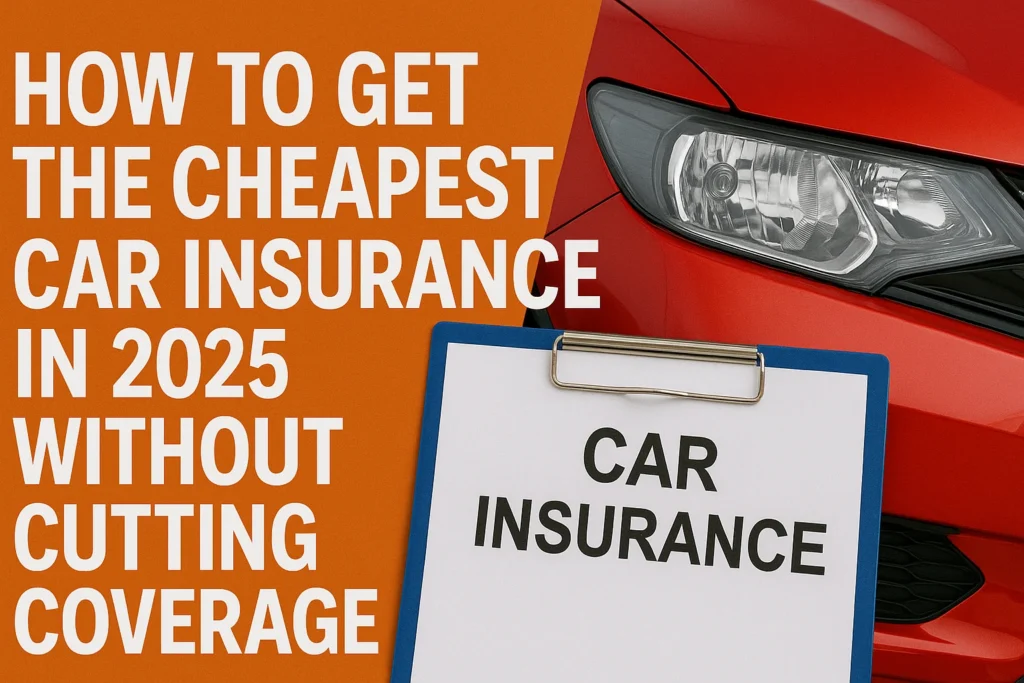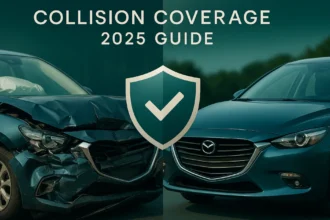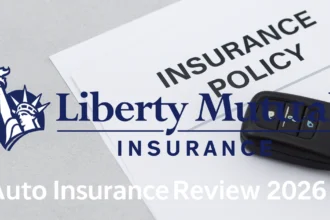The Insurance Crisis Hitting Your Wallet

Car insurance rates have skyrocketed 31% from 2023 to 2025, far outpacing inflation and income growth. The average driver now pays $2,638 annually for full coverage—but you don’t have to be average.
Here’s the reality: Most drivers are overpaying simply because they don’t know the system. While you can’t control rising repair costs or your location, you can master the factors that insurers actually use to calculate your rate.
Compare Car Insurance Quotes Now →
Use online comparison tools to get multiple quotes in under 60 seconds.
Why Car Insurance Costs Keep Rising
Three major factors are driving up premiums nationwide:
- Expensive repairs: Modern cars packed with technology cost more to fix
- Severe weather: Climate change increases comprehensive claims
- Medical costs: Rising healthcare expenses affect injury settlements
The good news? Smart shoppers are still finding significant savings by understanding how insurance companies compete for customers.
1. Shop Around (The #1 Money-Saver)
The average savings from switching: $400+ per year
Here’s what most people don’t realize: Insurance companies use completely different formulas to calculate rates. Your “high-risk” profile with one company might be “preferred” with another.
Quick Rate Comparison:
| Company | Average Annual Rate | Monthly Cost |
| Travelers | $1,709 | $142 |
| GEICO | $2,004 | $167 |
| Progressive | $2,155 | $180 |
| State Farm | $2,887 | $241 |
Pro tip: Get quotes from at least 3 companies annually. Rates change constantly, and last year’s best deal might not be this year’s winner.
Compare Car Insurance Quotes Now →
Use online comparison tools to get multiple quotes in under 60 seconds.
2. Stack Your Discounts
Most drivers miss out on 20-40% in available discounts. Here are the big ones:
Multi-Policy Bundling
- Home + Auto: Save up to 25%
- Multiple cars: 10-25% off each vehicle
- Motorcycle/RV: Additional 5-15%
Safe Driver Rewards
- Clean record: 10-30% discount
- Defensive driving course: 5-15% off
- Telematics programs: Up to 30% for safe driving
Life Stage Discounts
- Good student: 15-25% for B+ average
- Military/Veterans: Special rates with USAA
- Senior citizens: Age-based discounts after 50
Compare Car Insurance Quotes Now →
Use online comparison tools to get multiple quotes in under 60 seconds.
3. Master Your Deductibles
The strategy: Higher deductible = Lower premium
| Deductible | Annual Savings | 5-Year Break-Even |
| $500 → $1,000 | $200-400 | 1-2 accidents |
| $250 → $1,000 | $300-600 | 1-3 accidents |
Smart approach: Only raise deductibles on money you can actually afford to pay out-of-pocket.
4. Right-Size Your Coverage
Drop These If You Can Afford Repairs:
- Rental car coverage (if you have alternatives)
- Roadside assistance (if covered by AAA/credit cards)
- Gap insurance (for older, paid-off cars)
Keep These No Matter What:
- Liability coverage (increase limits if anything)
- Uninsured motorist protection
- Comprehensive/Collision (if car value > $4,000)
Warning: Don’t go for minimum coverage just to save money. One serious accident can cost $100,000+ in damages.
5. Improve Your Credit Score
The impact: Poor credit can increase rates by 76%
| Credit Level | Average Premium | vs. Good Credit |
| Excellent | $2,257 | -14% |
| Good | $2,638 | Baseline |
| Fair | $2,883 | +9% |
| Poor | $4,644 | +76% |
Quick wins:
- Pay bills on time for 6+ months
- Pay down credit card balances
- Check credit reports for errors
- Don’t close old credit cards
6. Consider Usage-Based Insurance
Perfect for: Low-mileage drivers (under 10,000 miles/year)
Programs like Allstate Drivewise or State Farm Drive Safe & Save can save 10-30% by tracking:
- Miles driven (less = lower rates)
- Driving times (avoid rush hour)
- Acceleration/braking (smooth = savings)
Real user testimonial: “I saved $300 my first year with telematics. It made me a more conscious driver too.” – Verified policyholder
7. Time Your Policy Changes Right
Best Times to Switch:
- Policy renewal (no cancellation fees)
- After major life changes (marriage, new job, move)
- Clean driving record milestone (3+ years accident-free)
Avoid These Timing Mistakes:
- Switching mid-policy (cancellation fees)
- Shopping only when rates increase
- Waiting until after an accident
The 5 Biggest Car Insurance Mistakes
- Auto-renewing without shopping – Costs $400+ annually
- Choosing minimum coverage – Leaves you financially exposed
- Ignoring available discounts – Missing 20-30% savings
- Not updating your profile – Paying for outdated risk factors
- Prioritizing price only – Cheap companies may deny claims
State-by-State Savings Opportunities
Highest savings potential:
- Michigan: $300+ average by switching
- Florida: $250+ with right discounts
- Louisiana: $400+ for clean records
Best overall value states:
- Idaho: $860 average full coverage
- Vermont: $764 average full coverage
- Ohio: $943 average full coverage
Your Action Plan: Save Money This Week
Day 1: Audit Your Current Policy
- Review coverage limits and deductibles
- List all current discounts
- Note your renewal date
Day 2-3: Get Comparison Quotes
- Contact 3-5 different insurers
- Use same coverage limits for fair comparison
- Ask about available discounts
Day 4: Optimize Your Profile
- Bundle policies if beneficial
- Increase deductibles if financially feasible
- Sign up for safe driver programs
Day 5: Make the Switch
- Choose best overall value (not just price)
- Schedule new policy to start on renewal date
- Cancel old policy after new one begins
Take Action: Your Insurance Savings Start Today
Car insurance doesn’t have to drain your budget. By shopping smart, optimizing your coverage, and taking advantage of available discounts, most drivers can save $300-800 annually without sacrificing protection.
The key is action. Insurance rates change monthly, and the best deals go to proactive shoppers who understand the system.
Your next step: Get personalized quotes from top-rated insurers in your area. It takes 10 minutes and could save you thousands over the next few years.
[Compare Top Insurance Companies Now →]
Don’t wait until renewal—start saving today
Frequently Asked Questions
Q: How often should I shop for car insurance?
A: At least once per year, or after major life changes like moving, getting married, or adding a teen driver. Insurance rates change frequently, and what was competitive last year might be overpriced today.
Q: Will getting quotes hurt my credit score?
A: No. Insurance quotes use “soft” credit checks that don’t affect your score. Only “hard” inquiries (like applying for credit cards) impact your credit rating.
Q: Is the cheapest insurance always the worst?
A: Not necessarily, but extremely cheap policies often have poor customer service, slow claim processing, or coverage gaps. Focus on value—good coverage at a fair price—rather than the absolute lowest cost.
Q: Can I switch insurance anytime?
A: Yes, but timing matters. Switch at your renewal date to avoid cancellation fees. Most policies require 30 days notice, so plan ahead.
Q: What’s the difference between liability and full coverage?
A: Liability covers damage you cause to others but not your own vehicle. Full coverage includes liability plus comprehensive and collision to repair/replace your car. If you can’t afford to replace your car out-of-pocket, keep full coverage.
Q: Do good grades really save money on car insurance?
A: Yes. Most insurers offer 15-25% discounts for students maintaining a B average or better. The discount typically applies until age 25 and can save hundreds annually.
Q: How much can bundling home and auto insurance save?
A: Typically 10-25% on both policies. However, bundling isn’t always cheapest—sometimes separate companies offer better individual rates. Always compare both options.
Q: What should I do immediately after an accident?
A: Stay safe, call police if needed, exchange information, take photos, and contact your insurance company within 24 hours. Don’t admit fault or discuss details beyond basic facts.
In another related article, How to Save on Car Insurance in 2025 (Even If You’re a New Driver)





